Guatemalan huipiles, a traditional, square-cut women’s blouse worn by Mayan women, are known for an abundance of colorful embroidery around the neckline. In the article “Red Is the Color of Patzún” in the March/April 2014 issue of PieceWork, Cynthia LeCount Samaké explains why red is the color of choice for huipiles worn by the women of Patzún.
First, Cynthia fills us in on a little background on the history of the color red.
- Because of Guatemala’s humid environment, few textiles have survived to give us information about ancient garments. . . . We have no way of discovering when Maya dyers began to use so much red.
- Sixteenth-century European chroniclers marveled at the variety of market goods in Mexico and Central America, specifically mentioning brilliant crimson cloth and scarlet feathers. In the Old World, the primary red dyestuffs then were madder root and the bodies or secretions of kermes and lac, two kinds of tiny scale insects that feed on the roots and stems of various plants in Europe and Asia. European guild dyers had found it both costly and difficult to produce the vivid deep red that royalty and the upper classes considered their hallmark of power and status.
- Explorers to the New World hoped to cash in on the red dye being used so successfully there. They discovered that the dye called “carmine” came from a third kind of scale insect, cochineal, which lives and feeds on the pads of prickly pear cactus (genus Opuntia) also called nopal. It is the fat, round bodies of the wingless adult females that cochineal harvesters brush off into bags, then dry, and grind for storage or shipping.
 Everyday Guatemalan huipil (square-cut women’s blouse). Purchased twenty-five to thirty years ago in Guatemala. Collection of Cynthia LeCount Samaké
Everyday Guatemalan huipil (square-cut women’s blouse). Purchased twenty-five to thirty years ago in Guatemala. Collection of Cynthia LeCount Samaké
Cynthia goes on to describe what makes the Patzún huipiles so special:
- The women of Patzún always have preferred hand embroidery over woven patterning: simple warp stripes suffice as a background for their embroidery. They weave the red-striped base cloth in the age-old way—on backstrap looms in two pieces with a seam down the middle. (Most huipiles in Guatemala are made this way.) A simple or complex hand-stitched pattern called a randa joins the two pieces.
Cynthia found that red was special to the Mayan women of Patzún for different reasons. To some, red represents: “el sangre de nuestros antepasados (the blood of our ancestors).” To others: “Red is the color of Patzún, our color.”
Read more of Cynthia’s account of visiting the exceptional needleworkers of Patzún and find a companion project in the March/April 2014 issue of PieceWork.
Also, remember that if you are an active subscriber to PieceWork magazine, you have unlimited access to previous issues, including March/April 2014. See our help center for the step-by-step process on how to access them.
Elizabeth Prose is a former assistant editor of PieceWork.
Originally published Mary 23, 2017; updated June 9, 2025.

